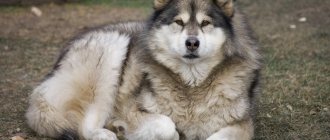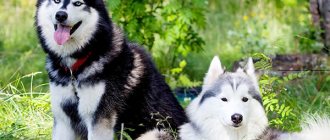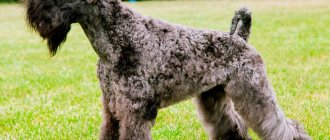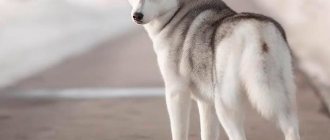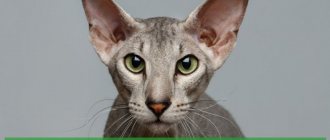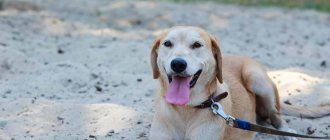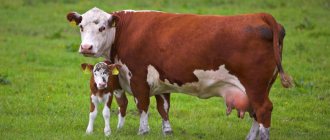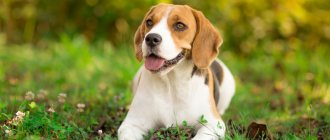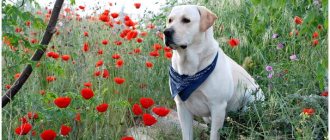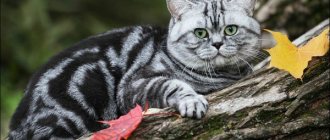Huskies, originally bred and used for a long time as sled dogs, have now become popular as pets and as participants in various dog shows.
However, the fashion for representatives of this breed has led to the appearance of many puppies that do not meet the breed standard. There are also more and more cases when outbred mestizos are sold under the guise of huskies.
Every future owner of a Siberian Husky needs to carefully study the breed standard before going for a pet.
What is the breed standard?
The Husky standard specifies the requirements for both the exterior of dogs of this breed and the characteristics of their character, temperament and behavior..
Having been officially adopted by the FCI in 1966, the breed standard may be subject to amendments or additions if the requirements for dogs are changed or new wishes of specialists appear, which purebred huskies will have to meet from then on.
Despite the fact that the standard was drawn up for all representatives of this breed, not all purebred dogs meet it.
The fact is that huskies have a peculiar division into three intra-breed groups - working, racing and show dogs.
It is the representatives of the latter group that most closely correspond to the breed standard, while working and racing dogs have a rather specific exterior.
After all, their physique, first of all, should be adapted for working in a harness, and not for victories in exhibition rings, when external showiness is the highest priority.
What does the RKF standard look like?
The dog is medium in size, with a compact but not coarse build.
The body is rectangular, tending towards a square format, that is, the height at the withers should be only slightly less than the length of the body:
- The head is proportional, with a moderately defined transition to a muzzle slightly tapering towards the nose.
- The ears are erect, triangle-shaped with slightly rounded ends, medium in size, turned forward when interested.
- The eyes are slightly slanted and almond-shaped. Both dark and bluish-blue colors of the iris are acceptable, and the standard does not prohibit heterochromia.
- The nose is medium in size, with well-opened nostrils. Depending on the color, it can be black, or light or dark brown.
- The neck is medium in length, moderately arched, and raised when standing.
- The shoulder blades are located at an angle of 45 degrees, while straight or too loose shoulders are a serious drawback.
- The chest is strong, powerful and quite deep, but not too voluminous.
- The forelimbs are parallel and level, moderately wide apart, with the elbows fitting tightly to the body.
- The hind legs are parallel, also moderately wide apart, with well-muscled thighs and well-defined angulations of the hock joints.
- The tail is medium in length, resembling a fox's in appearance, carried either lowered or in the shape of a sickle. Twisted into a ring, thrown over the back or tucked between the hind legs is considered unacceptable.
For huskies, the so-called “snow” pigmentation of the nose is also considered acceptable, when there are light veins on a dark background.
Expert opinion
Kozhevin Semyon Kirillovich
Expert dog handler.
“The Husky is a dog of medium height, with a compact but not powerful build. Its head is moderately wide, tapering towards the muzzle, its ears are triangular, erect, its tail is moderately pubescent, drooping downwards or in the shape of a sickle. Sexual dimorphism in these dogs is well expressed: females are lighter in build, but not weak or fragile. One of the most characteristic features of representatives of this breed, which many consider to be a kind of calling card of the husky, is blue or light blue eyes. In fact, among huskies there are many brown-eyed dogs, as well as animals with heterochromia.”
Head
I would rather classify a large head as a disadvantage of the breed. However, being too light and giving the impression of sophistication also does not fit into the standard . In order to understand how proportional the head is, I recommend comparing the distance from the tip of the nose to the beginning of the skull and from the beginning of the muzzle to the back of the husky’s head. As for the width, ideally this breed should have medium width.
Now about what else you should pay attention to:
- Lips – no looseness! But pigmentation, according to the standard, should be there.
- The eyes – their shape in this breed is strictly almond-shaped. They are widely spaced and slightly oblique. An important point: excessive distance is not encouraged, as is close planting. As for the color, of course, those who have ever seen the breed first remember blue. However, huskies often have brown eyes, and even heterochromia - different colors in one individual. The breed even has a mosaic coloration, which is not a defect - when the same eye has different shades.
- Ears – this breed can boast of cute triangular thick ears with rounded ends, located at a relatively short distance from each other. I can say that they are located quite high on the head. Well furred. The standard for Huskies does not include ears tilting forward. According to the same standard, too wide ear cartilage is discouraged, as is excessive softness of the ears, their placement too wide in relation to each other.
- The nose - the transition to it from the forehead should, according to the standard, be clearly expressed. A too narrow and long nose is not welcome. The color of the earlobe depends on the color of the husky: a gray Siberian dog has a black earlobe, a black one has a yellowish-brown earlobe, a copper-red one has a liver hue, and a white one has a flesh-colored earlobe. The breed often showed a nose with a pink stripe or a completely snowy nose - the standard fully allows for this.
- As for the bite, it must certainly be scissor-shaped. All the rest are considered vices.
Anatomical features of the muzzle
The length of the muzzle should correspond to the overall size of the head and be equal to the length of the skull.
The forehead is moderately convex, wider at the top, but tapering towards the muzzle. The stop is not sharp, but at the same time well marked. The bridge of the nose is smooth and straight, and the muzzle itself should end in a slight rounding.
The lips are dense, but not thick, their pigmentation color matches the color of the nose..
The jaws are strong, but not massive, the teeth are complete.
For Huskies, only a correct, scissor bite is considered acceptable.
Shade and color
Huskies have no restrictions on color; any coat color is acceptable for these dogs.
Their most common colors are gray-white and black-white. There are also fawn, brown and white and spotted huskies.
Pure black, white and brownish without white markings are very rare, but are standard and should not be disqualified.
However, despite the fact that almost all husky coat colors are considered standard, there are five main color options, which are recorded in breeding documents:
- White
- Gray-white
- Brown-white
- Fawn white
- Black and white
Typical of most Huskies is the presence of a mask on the face and around the eyes, and many dogs also have a not too wide white mark on the forehead.
Paw shape
Husky paws are oval, well adapted to cold climates and snowy winters..
The fingers are tucked into a ball, strong and arched, covered with hair. Many representatives of this breed have fifth, so-called dewclaws, on their front paws.
This is not a breeding match, however the fifth toes on the hind legs must be removed during puppyhood.
Movements
The Siberian Husky is characterized by smooth, easy movements without noticeable effort. At exhibitions, the dog's gait is taken into account, namely, a good extension of the front limbs, a good push of the hind limbs. To demonstrate the movements, the dog is led out on a loose leash and the dog must move at a moderately fast trot. While running, the back line remains clear and even.
Disadvantage: movement with short steps (mincing gait), skipping, limping gait, movement with crossing or divergence of limbs.
Source
Coat type
The husky's coat is thick and warm, not too long, but at the same time dense, perfectly protecting the dog from the cold.
NOTE!
Like other northern Spitz-type dogs, the husky has a double coat of hair, consisting of a well-developed and soft undercoat, as well as a medium-length spine, quite smooth and not bristling.
During shedding, the undercoat completely dies off, which is why the dog does not look as well “dressed” as usual..
Characteristic
According to the characteristics, Siberian huskies are active, cheerful, friendly animals. Dogs need constant physical activity, which requires regular walks in the fresh air. The breed is extremely hardy. Puppies are easy to train and quickly become attached to their owner, but they are somewhat stubborn. Due to their peaceful nature, they are completely unsuitable for the role of a hunting dog and as a guard.
Interesting ! The Chukchi used huskies as herding dogs in reindeer herding and as guard dogs.
Caring for a dog is simple. As a northern breed, it has a thick coat and requires regular brushing, especially during the molting period. It is preferable to keep them in suburban conditions: adult dogs are not afraid of the cold and calmly spend the night in the yard in winter.
Dog behavior
Husky has a lively and friendly character. They are smart and quick-witted, and these dogs also have the ability to perfectly adapt to different living conditions, which makes them suitable for both street and apartment living.
Huskies do not have guarding instincts, and although hunting instincts are present, they are not sufficiently developed..
This makes dogs of this breed unsuitable for service and hunting use.
However, their large size and rather stubborn and willful disposition make proper education and training of huskies necessary.
These dogs have a habit of howling rather than barking . In addition, huskies are considered masters of escape: they can make a tunnel in a short time or simply jump over an insufficiently high fence.
But huskies get along well with children and are very sociable, making them very good family dogs.
Can a dog change as it ages?
Husky puppies do not have guard hair, and the undercoat of these dogs is lighter, which is why the babies change color with age after the first molt, when the baby coat is replaced by an adult one..
Dogs that become grey-white as adults appear slightly yellowish as puppies, with a creamy coat on their body. Black and white huskies at an early age are grayish in body with white markings.
IMPORTANT!
You can understand what coat color an adult husky will have by looking at the color on its head, which will change little with age.
Also, as the dog matures, it becomes longer-legged, its muzzle lengthens, its chest becomes wider, and well-defined muscles appear.
It should be taken into account that racing and working dogs may look leaner and fitter than show dogs, and visually their legs usually appear longer.
Differences in appearance
Adults
- Male
Male huskies are slightly larger in size: their height can reach 60 cm and weight 28 kg. Outwardly they look larger and more massive. Physical indicators (endurance, strength) are slightly higher than those of females. They can have a variety of colors and eye colors, since this does not depend on gender.
- Bitch
The female has a smaller and more refined body, but her strength indicators remain at the same level. The curves of her body are more graceful, her movements are smoother. The height of husky bitches usually does not exceed 56 cm, and their weight is 23 kg, which makes them more dexterous and agile compared to cables. At the same time, females have less developed muscles and their strength indicators are lower.
Some dog breeders also note that they distinguish the sex of a given breed by the fullness of the tail - in females it is somewhat more magnificent. Externally, gender differences among Husky representatives appear only in size. Much more can be said from the animal's behavior and movements.
Puppy
A healthy purebred puppy has soft, medium-length fur that can come in a variety of colors. The tail is relatively short and well furred. When the baby is interested or excited, his tail rises. A healthy little husky puppy's tail looks like a crescent moon and does not fall over either the back or the side. The body and neck look very short when compared with adults.
The limbs are straight and rather short. The ears are slightly rounded at the ends and stick up, with more feathering than in adults. Newborn husky puppies may not look at all like adults: their ears are pressed tightly to the body, their limbs are short, and their necks are not pronounced.
Dear readers, share your experience of choosing a purebred purebred husky puppy.
How to distinguish a husky puppy from a mixed breed?
There is a list of external features by which you can distinguish a husky puppy from a mixed breed:
- A husky puppy's ears are quite dense, erect, with slightly pointed tips.
- The tail is carried down and never rises above the line of the back.
- The bones are strong and strong, and should not be light, nor too massive and rough.
- The bite should already be correct at an early age, in the form of scissors.
- Little huskies have a lively, moderately inquisitive character, they are energetic and have nothing against communicating with people.
It should be remembered that only the puppy's mark and brand are guarantees of the puppy's purebred, therefore, it is not recommended to buy a husky without documents.
You also need to take into account that without documents about its origin attached to the baby being purchased, blue eyes are by no means a sign that it is a husky.
This trait is often inherited by mixed-breed puppies, including those with unrelated breeds, even such as a German shepherd or pit bull.
Historical reference
It is known that people used dogs as draft force more than 4,000 years ago, but documentary evidence of this fact dates back 1.5 years ago. Domesticated wolves, jackal-type dogs, aboriginal dogs and all kinds of crosses have shared shelter with humans for centuries. Later, from this huge diverse group, dogs were identified that were similar in working qualities and appearance. Thus, breed groups of northern aboriginal dogs were formed, which became the ancestors of modern pets. The Siberian Husky dog breed is rightfully considered the most famous among the “northern pets”, although in recent years Laikas and Malamutes have been steadily rising in popularity ratings.
This is interesting! As you know, naming breeds by their distinctive characteristics is considered the norm in cynology to this day. Translated from English, the word “husky” is interpreted as hoarse or hoarse. Representatives of the breed rarely bark; they usually make growling sounds similar to a hoarse bark.
The origins of the Siberian Husky are somewhat obscure. At the time of the birth of the breed, absolutely all Eskimo dogs with thick fur and polar colors were called huskies, without dividing the dogs according to exterior characteristics. Later, a small distinction did appear; Laek, whose height reached 51 cm, was also included in the breed group. According to available data, the history of the breed began in Greenland, where the local population hunted and needed strong, hardy dogs.
Difficulties in describing the history of the breed are associated not with the breeding technique, but with the lifestyle of the “breeders”. From the available data, the Chukchi and other northern peoples used dogs similar to modern huskies as early as 3,000 years ago. But these facts have not been confirmed, since writing was (and remains) alien to the northern peoples. Denying progress and following established traditions, the Eskimos continued their aboriginal way of life even during times of great progress.
Northern dogs living in the region were divided into two types. The first were adapted for herding deer and protecting homes; they lived with people on lands remote from the coast. Cattle breeders' dogs were larger and more powerful than the four-legged animals that lived in the coastal zone, from which, in turn, the Siberian Huskies originated. The peoples living on the shores of the Northern Ocean did not leave their territories and lived by hunting and fishing. For the Chukchi, who “settled” on the coast at the time of the birth of progress, the war for the Bering Strait became a rather difficult test. The fighting pushed local residents deeper into the continent, thereby distancing them from the “hot” hunting grounds. This is where the need arose for strong, hardy and “economical” dogs that could carry a team to the fishing site and back.
This is interesting! Huskies apparently inherited their independence and disobedience to violence from their first owners. The forces of the Russian Empire tried to “absorb” the Chukchi territories several times, but to no avail. The peoples either did not agree to join (in the case of peace proposals), or left the place of conflict and continued their everyday lives.
Attempts at “suppression” ended only in the 18th century, when Russia granted independence to the northern people. However, the bright future did not materialize; in the 20th century, the USSR again encroached on the independence of the Chukchi. It was about an invasion of lands that from time immemorial “belonged” to hunters. The fact of importing dogs from Europe and Asia had an extremely negative impact on the purebred husky.
By the will of the Union, the established rules for breeding dogs were “redrawn”. All northern quadrupeds were divided into 4 groups, 3 of which were used for hunting. Eskimo huskies did not fit into any of the categories; they were small for sledding and weak for hunting. By banning breeding and later beginning the destruction of the breed group, the “iron will” of the Soviet Union eradicated even the hope of preserving the primary, pure gene pool of Siberian Huskies.
History always develops in turns and people regretted that they did not value light, easy-to-keep dogs. The moment of regret coincided with the discovery of gold deposits in Alaska. The speed, mobility, endurance and unpretentiousness of dogs have increased dramatically in price. The remaining, or rather, surviving huskies suddenly acquired value, and a serious “hunt” began for them.
How to choose a purebred pet?
Having decided to purchase a pet of this breed, you need to decide on its future purpose.
The fact is that puppies, even in the same litter, differ greatly in quality: some of them are more promising for exhibitions or for breeding, while others are suitable only for the role of pets.
If you just need a companion, then choosing a baby will not be so difficult: you just need to choose the one of the puppies that you liked more than the others, of course, provided that he is healthy and active enough.
When choosing a show- or breed-class pet, it is recommended to either seek advice from a specialist, or trust the breeder and ask him to select the most promising baby.
When purchasing a husky puppy, you should also take into account that its color may differ significantly from the coat color that will be later, after the pet has shed.
